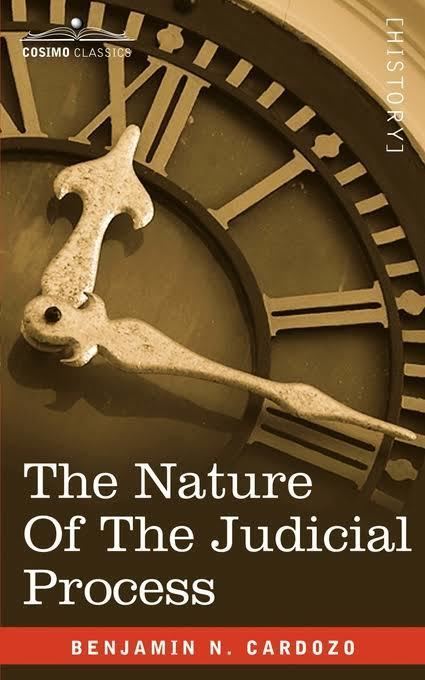7.6 /10 1 Votes7.6
Language English Originally published 1921 | 3.8/5 Goodreads Publication date 1921 Country United States of America | |||||||||||||||||||||||||||||||||
 | ||||||||||||||||||||||||||||||||||
Similar Benjamin N Cardozo books, Law books, Judiciary books | ||||||||||||||||||||||||||||||||||
The Nature of the Judicial Process is a legal classic written by Associate Justice of the United States Supreme Court, and New York Court of Appeals Chief Justice Benjamin N. Cardozo in 1921. It was compiled from The Storrs Lectures delivered at Yale Law School earlier that year.
Contents
Summary
The central question of The Nature of the Judicial Process is how judges should decide cases. Cardozo’s answer is that judges should do what they have always done in the Anglo-American legal tradition, namely, follow and apply the law in easy cases, and make new law in hard cases by balancing competing considerations, including the paramount value of social welfare. Cardozo identifies four leading methods of legal analysis: (1) the method of logic (or “analogy,” or “philosophy”), which seeks to extend legal principles in ways that preserve logical consistency; (2) the method of history (or “evolution”), which adverts to the historical origins of the legal rule or concept; (3) the method of custom (or “tradition”), which views social customs as helpful guides to community values and settled expectations; and (4) the method of sociology, which looks to considerations of reason, justice, utility, and social welfare. Each of these methods may have their “preponderating value” in particular cases. No simple test or rigid formula can decide which method should prevail in a given case. But in difficult cases where a legal rule is outmoded or the law contains “gaps” that must be filled, judges should frankly play the role of legislators and let “the welfare of society fix the path.”
Cardozo admits that there are risks in judicial lawmaking. To minimize these, he points to a number of factors that significantly limit judicial discretion. First, judges may make new law only “interstitially,” that is, when the law contains gaps or a legal rule is clearly obsolete. Second, judges in their exercise of judicial review should never strike down a law unless it is “so plainly arbitrary and oppressive that right-minded men and women could not reasonably regard” it otherwise. Finally, when judges invoke norms such as “reason,” “justice,” or “social advantage” when employing the method of sociology, they should look to community standards rather than to their own personal values. In the Anglo-American system of law, Cardozo remarks, a judge “is not a knight-errant, roaming at will in pursuit of his own ideal of beauty or of goodness.” In the final balance, a judge’s freedom to innovate is insignificant “compared with the bulk and pressure of the rules that hedge him on every side.”
In claiming that judges do and must make law, Cardozo was siding with Oliver Wendell Holmes, Jr., Roscoe Pound, John Chipman Gray, and other American “proto-realists” of his day who were challenging the traditional “oracular” or “mechanical” or “formalist” view of judicial reasoning. On that view, judges never make law, they simply discover pre-existing law and apply it. According to strict formalists, there are no hard cases where the law is silent, or ambiguous, or vague, or contradictory, or couched in broad generalities. Rather, the law is clear, consistent, and complete; all legal questions have a single correct answer; and judges are (in Blackstone's phrase) “living oracles” who deduce inexorable legal conclusions from indisputable legal axioms.
Formalism was not Cardozo’s only target in The Nature of the Judicial Process. He also attacked radical critics of formalism, such as John Chipman Gray, who claimed that judges have immense freedom and rejected the very idea of law as a set of binding rules. Gray and other proto-realists of the time tried to demystify law and view it with hard-headed pragmatism. They argued that since judges are the ultimate arbiters of law, “law” in the final analysis is whatever judges say it is (or what they predictably will say it is in the future). Cardozo argued that this isn’t an “analysis” of law, but a denial that any true law exists. The proto-realists confuse right with power. Judges may have the power to ignore settle legal standards, but they do not have the right. Moreover, the attempt to identify law with judicial rulings ignores the fact that the great majority of legal questions have clear, uncontroversial answers that guide everyday conduct and are never litigated in courts.
Reception and influence
The Nature of the Judicial Process established Cardozo “as one of the leading jurists of his time” and “has become a classic of legal education." Its continuing appeal is due, in part, to its self-effacing tone, its lapidary prose, and its attempt to strike a happy medium between legal formalism and radical realist theories that wholly reject traditional views of law, legal reasoning, judicial restraint, and the rule of law.
The great success of Cardozo’s The Nature of the Judicial Process created demand for further reflections on the law. In two later works, The Growth of Law (1924) and The Paradoxes of Legal Science (1927), Cardozo refined, deepened, and to some extent modified the views of law laid out in The Nature of the Judicial Process.
